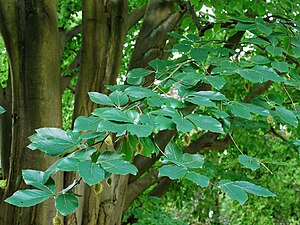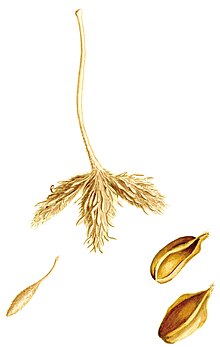Orient beech
| Orient beech | ||||||||||||
|---|---|---|---|---|---|---|---|---|---|---|---|---|

Leaves, fruits and trunk of the oriental beech ( Fagus orientalis ) |
||||||||||||
| Systematics | ||||||||||||
|
||||||||||||
| Scientific name | ||||||||||||
| Fagus orientalis | ||||||||||||
| Lipsky |
The oriental beech ( Fagus orientalis ) is a tree from the genus of the beech ( Fagus ). It is closely related to the common beech ( F. sylvatica ); It is distributed as its subspecies Fagus sylvatica ssp. orientalis ( Lipsky ) Greuter & Burdet .
description
The oriental beech is a forest tree with heights of growth of up to 40 meters (maximum even up to 50), making it somewhat higher than the common common beech ( Fagus sylvatica ), which usually only reaches 30 meters in height. The diameter of the trunk at chest height reaches one meter. Like Fagus sylvatica s. st. it has a gray, smooth bark that is often a little lighter than this one. The pointed buds reach about 20 (15-30) millimeters in length. The short-stalked foliage leaves are ovate to lanceolate to the reverse ovate (obovate) and are pointed at the apex; the leaf shape of the oriental beech is said to be more often inverted egg-shaped than that of the common red beech. The leaf margin is usually entire and smooth to wavy, but especially in populations from the eastern parts of the distribution area, shadow leaves in particular can have a clearly toothed leaf margin. The leaves usually reach 9 to 12 (rarely up to 15) centimeters in length with 8 to 12 (-13) pairs of lateral nerves; they are thus larger than those of Fagus slyvatica s. st. They are paper-like thin to leathery. Ripe leaves are hairy on the underside along the midrib and in the armpits of the lateral nerves, less often they are glabrous or almost glabrous. The leaf margin and the blade of young leaves are hairy silky.
The male flowers sit in hanging, tuft-like inflorescences, the perianth is four- to six-lobed and usually only slightly deeply incised, usually the tips are only half as long as the tube, with mostly 12 (from 8 to 16) stamens. The female flowers sit in twos, each with three stigmas, they are surrounded by four bracts that lignify when the fruit is ripe and form a four-lobed cup-shaped envelope, called a fruit cup or cupula, in which two fruits ( beechnuts ) sit. The winged nuts are about as long as the cupula. The most important distinctive morphological feature to the common European beech are the scales on the outside of the cupula. These are, at least towards the tip, flattened and clearly spatulate. They can even have a long, evergreen appendix, especially in populations of Asia Minor, but the European representatives lack this.
The number of chromosomes is 2n = 24, less often 22 or 34.
distribution

The oriental beech is found in the south-eastern Balkans, Asia Minor , northern Persia and the Caucasus . The European occurrences are on the Bulgarian Black Sea coast (isolated outposts as far as Romania) and in northeastern Greece, they close eastward to the closed range of Fagus sylvatica s. st. in the contact zone, she prefers the warmer and drier locations. It occurs in a closed area in European Turkey, south of the Sea of Marmara in the Asian part and from there eastward, in the mountains along the Black Sea coast ( Pontic Mountains ) to the east of the Caucasus. There are isolated, island-like occurrences far away on the Crimean peninsula north of the Black Sea (but these are widely separated as an independent Crimean beech clan ) and in the Amanos Mountains on the Turkish Mediterranean coast. The easternmost occurrences are the Hyrcania called Landscape ( Caspian Hyrcanian mixed forests ), between the Caspian Sea and the chains of the Alborz Mountains in Iran.
In the Balkans, especially in Bulgaria and in eastern Greece, there are extensive populations that are intermediate in morphological characteristics to the common European beech; these were formally described as Moesian beech Fagus moesiaca (Domin, Maly) Czeczott (named after the ancient Moesia ). The beeches of the mountains of the Crimean peninsula also have a morphology with features between those of the oriental beech and the common red beech; they were called Fagus taurica Popl. taken (named after Tauris , the ancient name of Crimea). For a long time it has been suspected that both of them were caused by hybridization between red beech and oriental beech. According to more recent genetic findings, probably only Fagus taurica actually goes back to a hybridization, while the beeches of the Balkans were already intermediate in their characteristic expression in their origin, thus refer to an incomplete separation of the clans. Oriental beeches from the easternmost parts of the distribution area were called Fagus sylvatica subsp. Hohenackeriana Shen differentiated; however, this subspecies is usually no longer recognized.
In the mountains of the Turkish Black Sea coast it rises to 2200 meters above sea level. NN. It grows in mixed forests with the Nordmann fir , with oaks and pines . In the west of the distribution area there are hybrids with the common beech . In Central Europe, the oriental beech is planted as a park tree. The oriental beech is one of the most vigorous and most important forest-forming deciduous trees in Asia Minor and neighboring regions.
use
The wood of the Fagus orientalis is heavy, hard, strong and resistant. These properties make it suitable for steam bending. The wood is well suited as firewood and can be used for veneer and plywood , chipboard also for wooden structures, furniture, floor coverings, pit wood , railway sleepers and for making paper.
The oriental beech shows rather slow youth growth, it reaches maximum growth rates around 30 to 40 years of age (in shadows up to 60) and under favorable conditions continues to grow up to the age of around 100 years, after which there is no more substantial growth. In less favorable locations with slow youth growth, growth can continue up to the age of approx. 200 years. The species has light colored wood, the heartwood is often reddish. In terms of use, it does not differ very much from the wood of common red beech, it is particularly suitable as firewood. In the case of the oriental beech, an oil that can be used for human consumption can also be pressed from the beechnuts.
After felling, the species often drives out of the stump vegetatively, but the trunks that have grown in this way are of inferior forest quality. It can be increased by sowing the beechnuts. These, however, do not tolerate drying out at room temperature, they can be stored for a few years if there is little frost. They go through an obligatory dormancy of 9 to 14 weeks in cool temperatures. Propagation via cuttings is not possible. The most important forest pest is the parasitic fungus Phytophthora omnivora .
Taxonomy and systematics
The oriental beech was described in 1895 by the Ukrainian botanist Wladimir Ippolitowitsch Lipski . Before that, Augustin-Pyrame de Candolle had already differentiated a variety asiatica for the eastern beeches . Taxonomic status has been controversial since the beginning of the 20th century until today. Mostly it was called Fagus sylvatica subsp. orientalis , so in the rank of a subspecies , so for example by Denk and in the Flora Europaea. However, many botanists and foresters viewed them as a separate species. The two clans can hybridize freely with one another, they cannot be distinguished from one another based on the pollen. The distribution of the distinguishable alleles also does not allow reliable differentiation. Thomas Denk and other botanists even went so far, due to the small genetic difference, to regard both as synonyms . Recent genetic investigations, in which material from the entire distribution area of the oriental beech was taken into account for the first time, suggest that the beeches have spread from the east to Europe, so that the first split separates the beeches of Iran from the more widespread ones . Accordingly, if Fagus sylvatica subsp. sylvatica in the traditional conception the oriental beech paraphyletic . A version of the clan in species rank would then hardly be justified.
literature
- Peter Schütt (Hrsg.): Lexicon of forest botany. ecomed, Landsberg / Lech 1992, ISBN 3-609-65800-2 , pp. 166-167.
Individual evidence
- ↑ a b T.G. Tutin (revised by JR Akeroyd): Fagus L. In: TG Tutin, NA Burges, JR Edmondson, AO Chater, VH Heywood, DM Moore, JR Akeroyd, DH Valentine, SM Walters, RR Mill, DA Webb, ME Newton (editors ): Flora Europaea. Volume 1: Psilotaceae to Platanaceae. 2., revised. Edition. Cambridge University Press, 1993. ISBN 0-521-41007-X . P. 36.
- ↑ a b Tomas Denk (1999): The taxonomy of Fagus in western Eurasia, 1: Fagus sylvatica subsp. orientalis (= F. orientalis). Feddes Repertory 110 (3/4): 177-200.
- ↑ a b c d Gaye Kandemir & Zeki Kaya (2009): Oriental Beech, Fagus orientalis. EUFORGEN Technical guidelines for genetic conservation and use. Bioversity International, Rome, Italy, 6 pages. ISBN 978-92-9043-804-5 .
- ^ Fagus orientalis at Tropicos.org. In: IPCN Chromosome Reports . Missouri Botanical Garden, St. Louis
- ↑ a b c Dušan Gömöry, Ladislav Paule, Vladimír Mačejovský (2018): Phylogeny of beech in western Eurasia as inferred by approximate Bayesian computation. Acta Societatis Botanicorum Poloniae 87 (2): 3582. doi: 10.5586 / asbp.3582
- ↑ Oriental beech on holzwurm-page.de, accessed on November 17, 2016.
- ^ Hanna Czeczott (1932): Distribution of Fagus orientalis Lipsky. Publications of the Geobotanical Institute Rübel in Zurich 8: 362-387.
Web links
- Distribution in the northern hemisphere according to Eric Hultén

